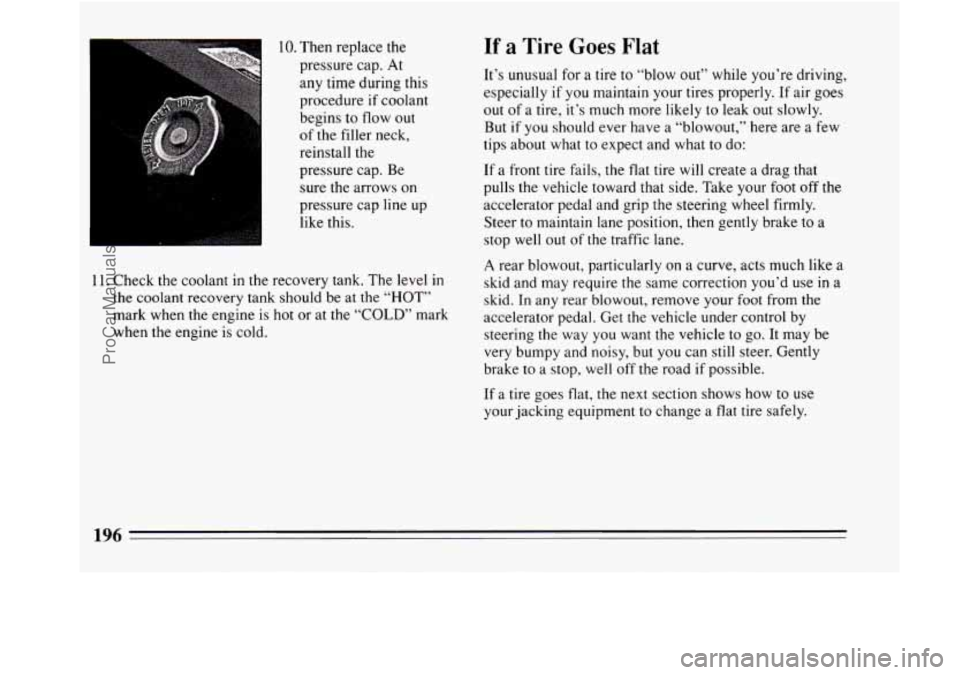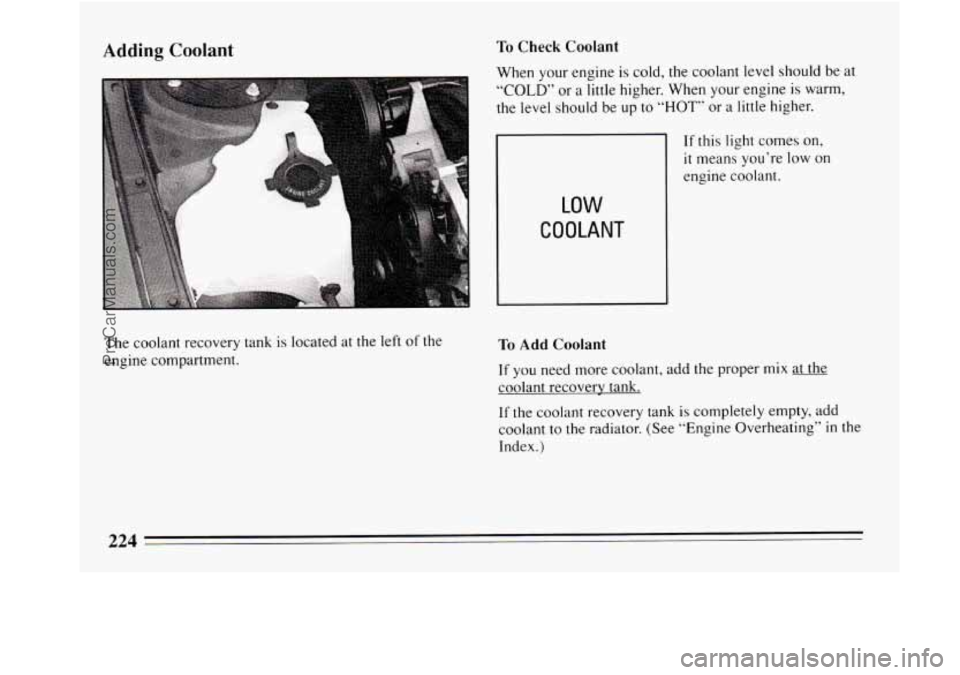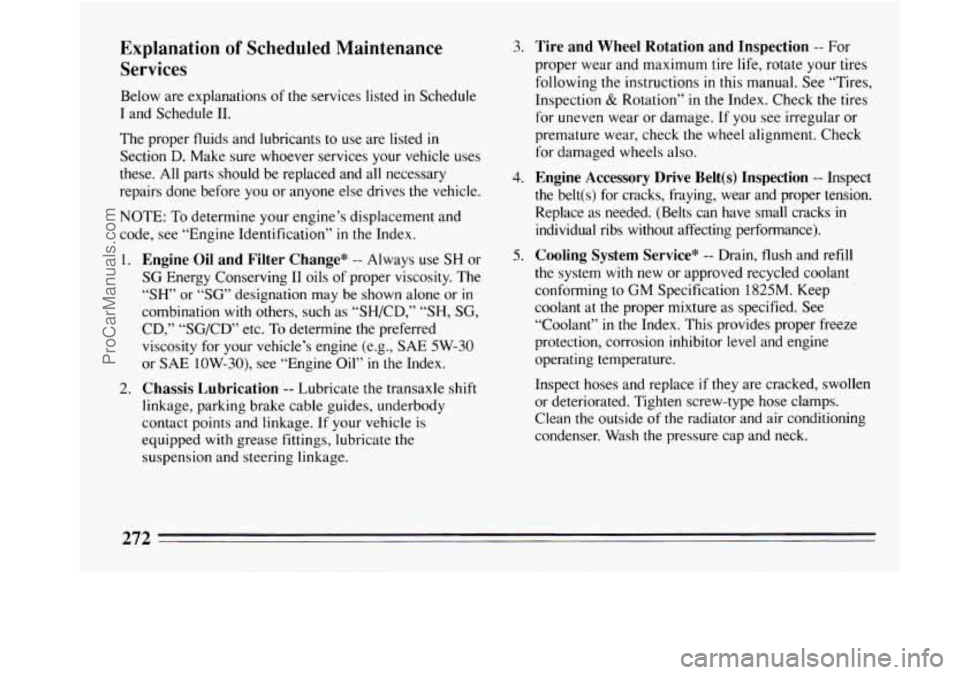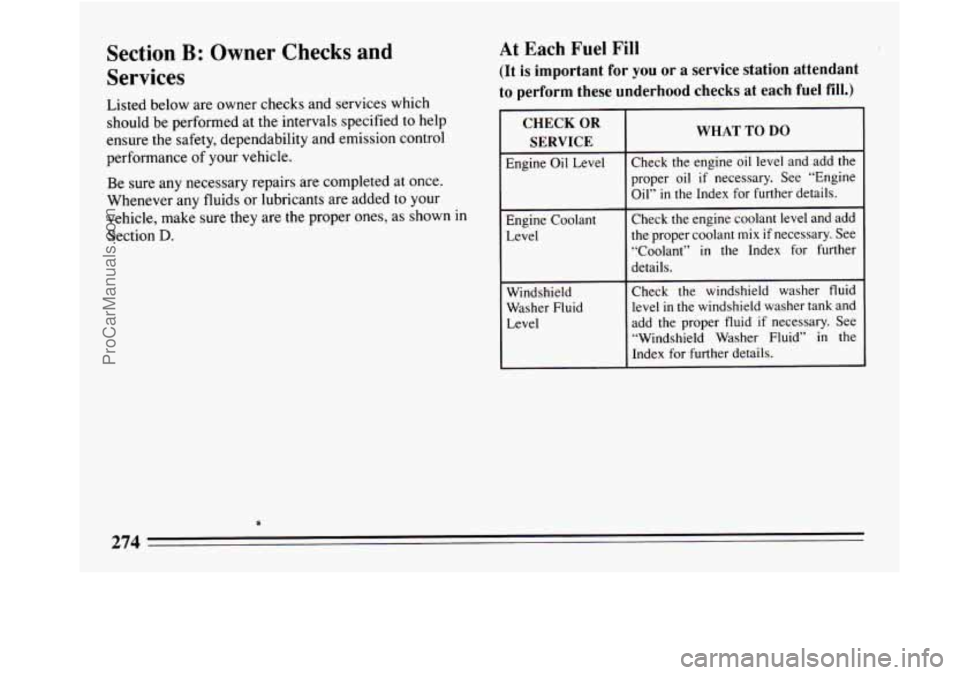1994 BUICK REGAL coolant level
[x] Cancel search: coolant levelPage 191 of 308

If the coolant inside the coolant recovery tank is boiling,
don’t do anything else until it cools down. The coolant level should be
at or above the
“COLD’
mark. If it isn’t, you may have a leak in the radiator
hoses, heater hoses, radiator, water pump or somewhere
else in the cooling system.
I NOTICE:
I
Engine damage from running your engine
without
coolant isn’t covered by your warranty. I
If there seems to be no leak, check to see if the electric
engine fan is running.
If the engine is overheating, the
fan should be running.
If it isn’t, your vehicle needs
service.
ProCarManuals.com
Page 192 of 308

How to Add Coolant to the Coolant
Recovery .Tank
If you haven’t found a problem yet, but the coolant level
isn’t at or above the “COLD” mark, add a
50/50 mixture
of clean water (preferably distilled) and a proper
antifreeze at the coolant recovery tank. (See “Engine
Coolant’’ in the Index for more information about
the
proper coolant mix.)
I NOTICE:
In cold weather, water can freeze and crack the
engine, radiator, heater core and other parts. Use
the recommended coolant.
190
ProCarManuals.com
Page 197 of 308

6. Then fill the coolant recovery tank to “COLD.”
7. Put the cap back on the coolant recovery tank, but
leave
the radiator pressure cap off.
A
8. Start the engine and let it run until you can feel the
upper radiator hose getting hot. Watch out for the
engine
fan( s).
9. By this time the coolant level inside the radiator
filler neck may
be lower. If the level is lower, add
more of the proper mix through the filler neck
until
the level reaches the base of the filler neck.
195
ProCarManuals.com
Page 198 of 308

10. Then replace the pressure cap. At
any time during this
procedure
if coolant
begins to flow out
of the filler neck,
reinstall the
pressure cap. Be
sure the arrows on
pressure cap line up
like this.
11. Check the coolant in the recovery tank. The level
in
the coolant recovery tank should be at the “HOT”
mark when the engine is hot or at the “COLD” mark
when the engine is cold.
If a Tire Goes Flat
It’s unusual for a tire to “blow out” while you’re driving,
especially
if you maintain your tires properly. If air goes
out
of a tire, it’s much more likely to leak out slowly.
But if you should ever have a “blowout,” here are a few
tips about what to expect and what to do:
If a front tire fails, the flat tire will create a drag that
pulls the vehicle toward that side. Take your foot off the
accelerator pedal and grip the steering wheel firmly.
Steer to maintain lane position, then gently brake to a
stop well out of the traffic lane.
A rear blowout, particularly on a curve, acts much like a
skid and may require
the same correction you’d use in a
skid. In any rear blowout, remove your foot from the
accelerator pedal. Get the vehicle under control by
steering the way you want the vehicle to go.
It may be
very bumpy and noisy, but you can still steer. Gently
brake
to a stop, well off the road if possible.
If a tire goes flat, the next section shows how to use
your jacking equipment to change
a flat tire safely.
ProCarManuals.com
Page 209 of 308

Part 6 Service and Appearance Care
Here you will find information about the care of your Buick . This part begins with service and fuel information. and
then
it shows how to check important fluid and lubricant levels . There is also technical information about your
vehicle. and a section devoted to its appearance care
.
Part 6 includes:
Service ........................................................................\
.. 208
Fuel
........................................................................\
..... 209
HoodRelease
..................................................................... 212
Engineoil
....................................................................... \
214
Aircleaner
....................................................................... \
219
Automatic Transaxle Fluid
................................................... : ....... 220
Enginecoolant
.................................................................... 223
PowerSteeringFluid
............................................................... 226
Windshield Washer Fluid
............................................................ 227
Brakes
........................................................................\
... 228
Battery
........................................................................\
.. 231
LoadingYourVehicle
............................................................... 235
Tires
........................................................................\
.... 236
Vehicle Identification Number (VIN)
.................................................. 253
Fuses and Circuit Breakers
....................... ’. ................................... 254
Capacities and Specifications
......................................................... 260
BulbReplacement
................................................................. 232
Appearancecare
.................................................................. 244
207
ProCarManuals.com
Page 226 of 308

Adding Coolant
The coolant recovery tank is located at the left of the
engine compartment.
To Check Coolant
When your engine is cold, the coolant level should be at
“COLD” or a little higher. When your engine is warm,
the level should be up to
“HOT” or a little higher.
LOW
COOLANT
If this light comes on,
it means you’re low on
engine coolant.
To Add Coolant
If you need more coolant, add the proper mix at the
coolant recovery tank.
If the coolant recovery tank is completely empty, add
coolant to the radiator. (See “Engine Overheating” in the
Index.)
224
ProCarManuals.com
Page 274 of 308

Explanation of Scheduled Maintenance
Services
Below are explanations of the services listed in Schedule
I and Schedule 11.
The proper fluids and lubricants to use are listed
in
Section D. Make sure whoever services your vehicle uses
these. All
parts should be replaced and all necessary
repairs done before you or anyone else drives the vehicle.
NOTE: To determine your engine’s displacement and
code, see “Engine Identification”
in the Index.
1.
Engine Oil and Filter Change* -- Always use SH or
SG Energy Conserving I1 oils of proper viscosity. The
“SH” or “SG” designation may be shown alone or in
combination with others, such as “SH/CD,” “SH, SG,
CD,” “SG/CD” etc.
To determine the preferred
viscosity for your vehicle’s engine (e.g., SAE 5W-30-
or SAE 10W-30), see “Engine Oil” in the Index.
2. Chassis Lubrication -- Lubricate the transaxle shift
linkage, parking brake cable guides, underbody
contact points and linkage. If your vehicle is
equipped with grease fittings, lubricate the
suspension and steering linkage. 3.
4.
5.
Tire
and Wheel Rotation and Inspection -- For
proper wear and maximum tire life, rotate your tires
following the instructions
in this manual. See “Tires,
Inspection
& Rotation” in the Index. Check the tires
for uneven wear or damage. If you see irregular or
premature wear, check the wheel alignment. Check
for damaged wheels also.
Engine Accessory Drive Belt(s) Inspection -- Inspect
the belt(s) for cracks, fraying, wear and proper tension.
Replace as needed. (Belts can have small cracks
in
individual ribs without affecting performance).
Cooling System Service* -- Drain, flush and refill
the system
with new or approved recycled coolant
conforming to GM Specification
1825M. Keep
coolant at the proper mixture as specified. See
“Coolant”
in the Index. This provides proper freeze
protection, corrosion inhibitor level and engine
operating temperature.
Inspect hoses and replace if they are cracked, swollen
or deteriorated. Tighten screw-type hose clamps.
Clean the outside of the radiator and air conditioning
condenser. Wash the pressure cap and neck.
272
ProCarManuals.com
Page 276 of 308

Section B: Owner Checks and
Services
Listed below are owner checks and services which
should be performed at the intervals specified to help
ensure the safety, dependability and emission control
performance
of your vehicle.
Be sure any necessary repairs are completed at once.
Whenever any fluids or lubricants are added to your
vehicle, make sure they are
the proper ones, as shown in
Section
D.
At Each Fuel Fill
(It is important for you or a service station attendant
to perform these underhood checks at each fuel fill.)
CHECK OR
I SERVICE
Engine Oil Level
Level
Level
WHAT TO DO
Check the engine oil level and add the
proper oil
if necessary. See “Engine
Oil” in the Index for further details.
Check the engine coolant level and add
the proper coolant
mix if necessary. See
“Coolant”
in the Index for further
details.
Check the windshield washer fluid
level
in the windshield washer tank and
add the proper fluid
if necessary. See
“Windshield Washer Fluid” in the
Index for further details.
0
274
ProCarManuals.com